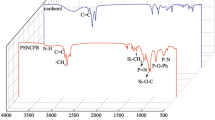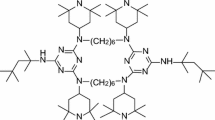Abstract
The high solid resol phenolic resin was prepared via step polymerization of formaldehyde, paraformaldehyde, and phenol using sodium hydroxide and calcium oxide as catalysts, and employed to prepare the phenolic foams (PFs) by the introduction of retardant additives including eco-friendly halogen-free flame retardants (ammonium polyphosphate), char-forming agents (pentaerythritol), and synergists (zinc oxide, molybdenum trioxide, cuprous chloride, and stannous chloride). The effects of these additives on flame retardancy, heat resistance, and fire properties of flame-retardant composite phenolic foams (FRCPFs) were evaluated by limiting oxygen index (LOI) tests, thermogravimetric analyzer, and cone calorimeter tests. It was found that the flame retardan significantly increased the LOIs of FRCPFs. Compared with PF, heat release rate, total heat release, effective heat of combustion, production or yield of carbon monoxide (COP or COY), and Oxygen consumption (O2C) of FRCPFs all remarkably decreased. However specific extinction area and total smoke release significantly increased, which agreed with the gas-phase mechanism of the flame-retardant system. The results indicate that FRCPFs have excellent fire-retardant performance and less smoke release. APP/PER/ZnO is shown to be better flame-retardant system for PFs.











Similar content being viewed by others
References
Schipper P, Black J, Dymeck T. Foamed rigid vinyl for building products. J Vinyl Addit Technol. 1996;2:304–9.
Matuana LM, Park CB, Balatinecz J. The effect of low level of plasticizer on the rheological and mechanical properties of polyvinyl chloride/new sprint-fiber composites. J Vinyl Addit Technol. 1997;3:265–73.
Juntunen RP, Kumar V, Weller JE, Bezubic WP. Impact strength of high density microcellular PVC foams. J Vinyl Addit Technol. 2000;6:93–9.
Stec AA, Hull TR. Assessment of the fire toxicity of building insulation materials. Energy Build. 2011;43:498–506.
Lei SW, Guo QG, Zhang DQ, Shi JL, Liu L, Wei XH. Preparation and properties of the phenolic foams with controllable nanometer pore structure. J Appl Polym Sci. 2010;117:3545–50.
Shen HB, Lavoie AJ, Nutt SR. Enhanced peel resistance of fiber reinforced phenolic foams. Compos A. 2003;34:941–8.
Shen HB, Nutt S. Mechanical characterization of short fiber reinforced phenolic foam. Compos A. 2003;34:899–906.
Yang HY, Wang X, Yuan HX, Song L, Hu Y, Yuen RKK. Fire performance and mechanical properties of phenolic foams modified by phosphorus-containing polyethers. J Polym Res. 2012;19:9831–40.
Rangari VK, Hassan TA, Zhou YX, Mahfuz H, Jeelani S, Prorok BC. Cloisite clay-infused phenolic foam nanocomposites. J Appl Polym Sci. 2007;103:308–14.
Auad ML, Zhao LH, Shen HB, Nutt SR, Sorathia U. Flammability properties and mechanical performance of epoxy modified phenolic foams. J Appl Polym Sci. 2007;104:1399–407.
Wu K, Wang ZZ, Hu Y. Microencapsulated ammonium polyphosphate with urea-melamine-formaldehyde shell: preparation, characterization, and its flame retardance in polypropylene. Polym Adv Technol. 2008;19:1118–25.
Wang LC, Jiang JQ, Jiang PK, Yu JH. Synthesis, characteristic of a novel flame retardant containing phosphorus, silicon and its application in ethylene vinyl-acetate copolymer (EVM) rubber. J Polym Res. 2010;17:891–902.
Wu K, Song L, Wang ZZ, Hu Y. Preparation and characterization of double shell microencapsulated ammonium polyphosphate and its flame retardance in polypropylene. J Polym Res. 2009;16:283–94.
Mathan ND, Arunjunairaj M, Rajkumar T, Ponraju D, Vijayakumar CT. Thermal degradation of pentaerythritol phosphate alcohol TG and TG-MS studies. J Therm Anal Calorim. 2011;110:1133–41.
Camino G, Grassie N, McNeill IC. Influence of the fire retardant, ammonium polyphosphate on the thermal degradation of poly (methyl methacrylate). J Polym Sci Polym Chem Ed. 1978;16:95–106.
Li B, Sun CY, Zhang C. An investigation of flammability of intumescent flame retardant polyethylene containing starch by using cone calorimeter. Chem J Chin Univ. 1999;20:146–9.
Li B, Xu MJ. Effect of a novel charring foaming agent on flame retardancy and thermal degradation of intumescent flame retardant. Polym Degrad Stab. 2006;91:1380–6.
Allen DW, Edwyn C. Structure-property relationships in intumescent fire retardant derivatives of 4-hydroxymethyl-2, 6, 7-trioxa-1-phosphabicyclo [2, 2, 2] octane-1-oxide anderton. Polym Degrad Stab. 1994;45:399–408.
Hu XP, Li YL, Wang YZ. Synergistic effect of the charring agent on the thermal and flame retardant properties of polyethylene. Macromol Mater Eng. 2004;289:208–12.
Almeras X, Dabrowski F, Bras ML, Delobel R, Bourbigot S, Marosi G, Anna P. Using polyamide 6 as charring agent in intumescent polypropylene formulations. II. Thermal degradation. Polym Degrad Stab. 2002;77:315–23.
Liu Y, Yi JS, Cai XF. The investigation of intumescent flameretarded polypropylene using poly (hexamethylene terephthalamide) as carbonization agent. J Therm Anal Calorim. 2012;107:1191–7.
Zhang Q, Cheng YH. Synergistic effects of ammonium polyphosphate/melamine intumescent system with macro- molecular char former in flame-retarding polyoxymethylene. J Therm Anal Calorim. 2011;18:293–303.
Jiao CM, Chen XL. Synergistic effects of zinc oxide with layered double hydroxides in EVA/LDH composites. J Therm Anal Calorim. 2009;98:813–8.
Yin HQ, Yuan DD, Cai XF. Red phosphorus acts as second acid source to form a novel intumescent-contractive flame-retardant system on ABS. J Therm Anal Calorim. 2012. doi:10.1007/s1097301225367.
Wang XL, Wu LH, Li J. Synergistic flame retarded poly (methyl methacrylate) by nano-ZrO2 and triphenylphosphate. J Therm Anal Calorim. 2011;103:741–6.
Yi JS, Liu Y, Cai XF. The synergistic effect of adjuvant on the intumescent flame retardant ABS with a novel charring agent. J Therm Anal Calorim. 2012. doi:10.1007/s1097301228028.
Ribeiro SPS, Estevão LRM, Nascimento RSV. Brazilian clays as synergistic agents in an ethylenic polymer matrix containing an intumescent formulation. J Therm Anal Calorim. 2007;87:661–5.
Yi JS, Yin HQ, Cai XF. Effects of common synergistic agents on intumescent flame retardant polypropylene with a novel charring agent. J Therm Anal Calorim. 2013;111:725–34.
PN-76/C-89020, Plastics. Determination of Ignitability by the Method of Limiting Oxygen Index (LOI).
Kim J, Lee JH, Kim S. Estimating the fire behavior of wood flooring using a cone calorimeter. J Therm Anal Calorim. 2012;110:677–83.
Lomakin SM, Dubnikova IL, Shchegolikhin AN, Zaikov GE, Kozlowski R, Kim GM, Michler GH. Thermal degradation and combustion behavior of the polyethylene/clay nanocomposite prepared by melt intercalation. J Therm Anal Calorim. 2008;94:719–26.
Janowska G, Kucharska-Jastrząbek A, Rybiński P. Thermal stability, flammability and fire hazard of butadiene- acrylonitrile rubber nanocomposites. J Therm Anal Calorim. 2011;103:1039–46.
Ye L, Qu BJ. Flammability characteristics and flame retardant mechanism of phosphate-intercalated hydrotalcite in halogen-free flame retardant EVA blends. Polym Degrad Stab. 2008;93:918–24.
Fang YQ, Wang QW, Bai XY, Wang WH, Cooper PA. Thermal and burning properties of wood flour (polyvinyl chloride) composite. J Therm Anal Calorim. 2012;109:1577–85.
Wang CC, Dai Z, Xu GW. Research on hard-segment flame-retardant modification of waterborne polyurethane. China Coat. 2010;8:57–60.
Ou YX, Li JJ. Frame retardant. Beijing: Chemical Industry Press; 2006.
Ou YX. Practical flame retardant technology. Beijing: Chemical Industry Press; 2003.
Zarate CN, Aranguren MI, Reboredo MM. Thermal degradation of a phenolic resin, vegetable fibers, and derived composites. J Appl Polym Sci. 2008;107:2977–85.
Ouyang ZH, Wu L, Yi DL, Qin XR, Cao SC, Wang Y, Lan L. Study on Mo PF used as bonding agent. Chem Ind Eng Prog. 2005;8:901–4.
Wu FC, Deng HF. Organic boron modified phenol ic resin heat of the study. J North China Inst Sci Technol. 2007;2:29–32.
Blanco I, Abate L, Bottino FA, Bottino P, Chiacchio MA. Thermal degradation of differently substituted cyclopentyl polyhedral oligomeric silsesquioxane (CP-POSS) nanoparticles. J Therm Anal Calorim. 2012;107:1083–91.
Blanco I, Oliveri L, Cicala G, Recca A. Effects of novel reactive toughening agent on thermal stability of epoxy resin. J Therm Anal Calorim. 2012;108:685–93.
ISO 5660 Reaction-to-fire tests-heat release, smoke production and mass loss rate.
Li B, Wang JQ. Utilization of cone calorimeter for the appraisal of the flammability and flame retardancy of polymeric materials. Polym Mater Sci Eng. 1998;5:15–9.
Deng XB, Wang JG, Liu BL. Application of cone calorimeter in the study of combustion properties on finishing fire retardant paint. Paint Coat Ind. 2011;12:50–3.
Almeras X, Bras ML, Hornsby P, Bourbigot S, Marosi G, Keszei S, Poutch F. Effect of fillers on the fire retardancy of intumescent polypropylene compounds. Polym Degrad Stab. 2003;82:325–31.
Manfredi LB, Rodríguez ES, Wladyka-Przybylak M, Vázquez A. Thermal degradation and fire resistance of unsaturated polyester, modified acrylic resins and their composites with natural fibres. Polym Degrad Stab. 2006;91:255–61.
Zhu XS, Pan QQ, Xu HS, Lu JM. Effects of coal and ammonium polyphosphate on thermal degradation and flame retardancy of polyethylene terephthalate. J Polym Res. 2010;17:621–9.
Yeh JT, Hsieh SH, Cheng YC, Yang MJ, Chen KN. Combustion and smoke emission properties of poly (ethylene terephthalate) filled with phosphorous and metallic oxides. Polym Degradation Stab. 1998;61:399–407.
Zhang J, Silcock GWH, Shields TJ. Study of the combustion and ire retardancy of polyacrylonitrile and its copolymers by using cone calorimetry. J Fire Sci. 1995;13:141–61.
Acknowledgments
The study was partially financially supported by the National Key Technology Research and Development Program of the Ministry of Science and Technology of China (2012BAD24B04) and National Natural Science Foundation of China (31200448).
Author information
Authors and Affiliations
Corresponding authors
Rights and permissions
About this article
Cite this article
Ma, Y., Wang, J., Xu, Y. et al. Preparation and characterization of phenolic foams with eco-friendly halogen-free flame retardant. J Therm Anal Calorim 114, 1143–1151 (2013). https://doi.org/10.1007/s10973-013-3180-6
Received:
Accepted:
Published:
Issue Date:
DOI: https://doi.org/10.1007/s10973-013-3180-6




